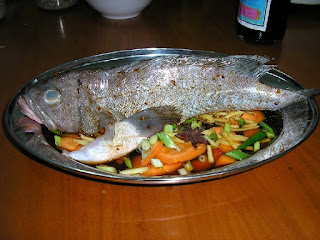Fish is part of a staple Malaysian diet, especially for the Chinese and it represents prosperity and the wealth status of the host. Fish is a must serve dish in every Chinese banquet. With the depletion of seafood products from our rich Straits of Malacca and the South China Sea, fish prices are soaring up the scale and thus aqua culture is the temporary solution for this problem currently.
I grew up near the sea and my family were pioneer fish merchants in Northern Malaysia. Fish is one of my favourite white meat as it is healthy. There are many ways to cook a fish (not skin a cat) and the most popular method for Chinese are steam fish. There are unlimited ways to steam a fish depending on the creativity of the chef.
Popular salt-water fishes such as Kerapu, Senangin, Siakap, Jenahak, Tauteh and many more are getting more and more expensive every year and especially during festive seasons such as Chinese New Year. There are around 7 types of Kerapu in Malaysia and the most popular ones in Peninsular Malaysia are the orange dotted Kerapu, which is the second most expensive and the light browned Kerapu. The most expensive Kerapu comes from Borneo which is called the 7 coloured Kerapu (directly translated from the Hokkien dialect).

The Kerapu and Siakap fishes are being cultured in a large scale as Kerapu is a popular fish for Chinese wedding banquets and Siakap is enjoyed by all the ethnics in Malaysia especially the Malays as Siakap is popular for Ikan Bakar (grilled fish/ restaurant serving seafood in Malay cuisine). Cultured fishes is nowhere compared to wild fishes in taste, texture and price.
In Kuala Lumpur, fresh water fishes is a popular alternative for the Chinese community. This situation was influenced by inland Perak and Pahang as they rely on freshwater fishes for white meat. Popular freshwater fishes are Carp, Ikan Hantu(Lam Kor Yi), Patin, Tilapia and Sultan fish. Freshwater fishes are hard to cook as the stomach of the fish has a stench of soil if not washed properly. Ikan Hantu is the most expensive fish in Peninsular Malaysia. I've eaten Ikan Hantu before, the texture of the fish is unbelievably delicate and the flavour of the fish is strong and pleasant. The last time I ate it, it cost me RM10.00 for 100gms plus cooking charges.
I would like to share a few tips and tricks so you can get that perfect steamed fish:
1. Buy a fresh fish. It would be the best if the fish is still moving when you buy it.
2. Starve your guests before serving your steamed fish and describe how fresh the fish was,
eg. how it was moving to cook up a desire to dine the fish mentally.
3. Make sure you don't overcook the fish or the texture will be hard.
4. Discard all the organs and the blood in the stomach immaculately.
5. De-scale the fish properly. You don't want scales in your mouth.
6. Apply some oil on the skin of the fish before steaming (Virgin olive or palm oil preferred).
7. Make sure your guest eat the fish while its still piping hot.
If you follow all the steps above, you will experience a good time eating your steamed fish with your guests or loved ones. Remember, fish is a very sensitive meat to prepare. It needs extra attention and love to cook fish. If you have any inquiries, please mail me @ vsleep@gmail.com


 It's sweet, it's tasty, it's cooling, it's starchy like beans should be. A dump on this will only cost you RM3.20 ++. The Greenbean promotion has a version in Greenbean McFlurry. I haven't tried that yet because it really lookes yucky and gross. It's like industrial waste sludge from Chernobyl that once eaten, will turn you into a creature with a curled tail, a snout and a thousand eyes. The McFlurry version will cost you RM4.30++. I call it McSludge.
It's sweet, it's tasty, it's cooling, it's starchy like beans should be. A dump on this will only cost you RM3.20 ++. The Greenbean promotion has a version in Greenbean McFlurry. I haven't tried that yet because it really lookes yucky and gross. It's like industrial waste sludge from Chernobyl that once eaten, will turn you into a creature with a curled tail, a snout and a thousand eyes. The McFlurry version will cost you RM4.30++. I call it McSludge.












